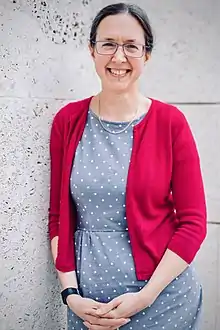Rachel Oliver (scientist)
Rachel Angharad Oliver FIMMM is a Professor of Materials Science at the University of Cambridge.[1] She works on characterisation techniques for gallium nitride materials for light-emitting diodes and laser diodes.[3][4]
Rachel Oliver | |
|---|---|
 Oliver in 2019 | |
| Born | Rachel Angharad Oliver |
| Alma mater | University of Oxford (MEng, DPhil) |
| Awards | Royal Society University Research Fellowship (2006-2011) |
| Scientific career | |
| Fields | Gallium nitride Advanced microscopy Quantum technology[1] |
| Institutions | University of Cambridge |
| Thesis | Growth and characterisation of nitride nanostructures (2003) |
| Doctoral advisor | Andrew Briggs[2] |
| Website | www |
Early life and education
Oliver studied engineering and materials science at the University of Oxford and completed an industrial placement in metallurgy.[5] Her final year masters project was in optoelectronic materials.[5] She completed her Doctor of Philosophy degree at the University of Oxford in 2003,[2] where she began to work with gallium nitride under the supervision of Andrew Briggs.[5] She used metalorganic vapour-phase epitaxy (MOVPE) to grow quantum dots.[5] During her PhD, she spent several months working in an industrial lab in America.[6]
Research and career
She joined the University of Cambridge in 2003 as a Royal Commission for the Exhibition of 1851 postdoctoral research fellow.[5] In 2006 Oliver was awarded a Royal Society University Research Fellowship (URF) at the University of Cambridge.[7] She studied the morphology of gallium nitride light-emitting diodes (LEDs), identifying what factors controlled their efficiency and the impact of defects.[7] She was awarded an Engineering and Physical Sciences Research Council (EPSRC) grant to study semi-polar nitride based structures.[8]
She was appointed a lecturer at the University of Cambridge in 2011.[9] Oliver studies gallium nitride materials for LEDs and laser diodes.[1][3][10] Her research considers ways to engineer the nanostructure of light emitting diodes and how this impacts macroscopic device performance.[10] She has developed atom-probe tomography and scanning capacitance microscopy to study nitride devices.[10]
Oliver is also working on single-photon indium gallium nitride quantum dots for quantum crystallography.[10][11] She has looked at the impact of threading dislocations on the quality factor of InGaN cavities. Her group developed the first blue-emitting single-photon source.[12][13][14] She was the first to note rabi oscillations of GaN quantum dots.[15][16] She designed a quasi-two-temperature growth method to pattern GaN quantum dots, which improved their emission by a factor of ten.[12][17]
Awards and honours
Oliver was elected a Fellow of the Institute of Materials, Minerals and Mining (FIMMM) in 2019. She held a Royal Society University Research Fellowship from 2006 to 2011.[7]
Personal life
Oliver’s husband is a cardiologist with whom she has a son.[9]
References
- Rachel Oliver publications indexed by Google Scholar

- Oliver, Rachel Angharad (2003). Growth and characterisation of nitride nanostructures. bodleian.ox.ac.uk (DPhil thesis). University of Oxford. OCLC 59185823. EThOS uk.bl.ethos.400219.
- Rachel Oliver publications indexed by the Scopus bibliographic database. (subscription required)
- Rachel Oliver publications from Europe PubMed Central
- Pain, Elisabeth (2010). "Structuring a Career Around Gallium Nitride". Science. American Association for the Advancement of Science. doi:10.1126/science.caredit.a1000032. Retrieved 2018-09-29.
- Anon (2018). "Contributors – Cambridge Science Centre". csc.webfactional.com. Retrieved 2018-09-29.
- Anon (2018). "Dr Rachel Oliver: Research Fellow". royalsociety.org. London: Royal Society. Archived from the original on 2018-09-30. Retrieved 2018-09-29.
- Oliver, Rachel (2019). "Study of semi-polar and non-polar nitride based structures for opto-electronic device applications". ukri.og. UK Research and Innovation. Retrieved 2018-09-29.
- Notman, Nina (2015). "The mothers of invention: Nina Notman profiles four researchers successfully balancing an academic career with family life". chemistryworld.com. Chemistry World. Archived from the original on 2020-08-20. Retrieved 2018-09-29.
- Wineman, Adina (2016-08-09). "Rachel Oliver". msm.cam.ac.uk. Retrieved 2018-09-29.
- Jarjour, Anas F.; Oliver, Rachel A.; Taylor, Robert A. (2009). "Nitride-based quantum dots for single photon source applications". Physica Status Solidi A. 206 (11): 2510–2523. doi:10.1002/pssa.200824455. ISSN 1862-6300.
- Anon (2016). "Collaboration Casts New Light On Quantum Dots - Science and Engineering". ses.ac.uk. Science and Engineering. Retrieved 2018-09-29.
- Jarjour, Anas F.; Taylor, Robert A.; Oliver, Rachel A.; Kappers, Menno J.; Humphreys, Colin J.; Tahraoui, Abbes (2007). "Cavity-enhanced blue single-photon emission from a single InGaN∕GaN quantum dot". Applied Physics Letters. 91 (5): 052101. doi:10.1063/1.2767217. ISSN 0003-6951.
- Aharonovich, Igor; Woolf, Alexander; Russell, Kasey J.; Zhu, Tongtong; Niu, Nan; Kappers, Menno J.; Oliver, Rachel A.; Hu, Evelyn L. (2013). "Low threshold, room-temperature microdisk lasers in the blue spectral range". Applied Physics Letters. 103 (2): 021112. arXiv:1208.6452. doi:10.1063/1.4813471. ISSN 0003-6951.
- Zhu, Tongtong; Liu, Yingjun; Ding, Tao; Fu, Wai Yuen; Jarman, John; Ren, Christopher Xiang; Kumar, R. Vasant; Oliver, Rachel A. (2017). "Wafer-scale Fabrication of Non-Polar Mesoporous GaN Distributed Bragg Reflectors via Electrochemical Porosification". Scientific Reports. 7 (1): 45344. doi:10.1038/srep45344. ISSN 2045-2322. PMC 5366952. PMID 28345612.
- Reid, Benjamin P. L.; Kocher, Claudius; Zhu, Tongtong; Oehler, Fabrice; Emery, Robert; Chan, Christopher C. S.; Oliver, Rachel A.; Taylor, Robert A. (2014). "Observations of Rabi oscillations in a non-polar InGaN quantum dot". Applied Physics Letters. 104 (26): 263108. doi:10.1063/1.4886961. ISSN 0003-6951.
- Wang, Tong; Puchtler, Tim J.; Zhu, Tongtong; Jarman, John C.; Oliver, Rachel A.; Taylor, Robert A. (2017). "High-temperature performance of non-polar (11-20) InGaN quantum dots grown by a quasi-two-temperature method". Physica Status Solidi B. 254 (8): 1600724. doi:10.1002/pssb.201600724. ISSN 0370-1972.